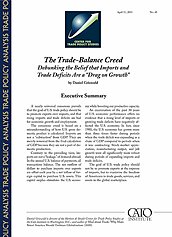A nearly universal consensus prevails that the goal of U.S. trade policy should be to promote exports over imports, and that rising imports and trade deficits are bad for economic growth and employment.
The consensus creed is based on a misunderstanding of how U.S. gross domestic product is calculated. Imports are not a “subtraction” from GDP. They are merely removed from the final calculation of GDP because they are not a part of domestic production.
Contrary to the prevailing view, imports are not a “leakage” of demand abroad. In the annual U.S. balance of payments, all transactions balance. The net outflow of dollars to purchase imports over exports are offset each year by a net inflow of foreign capital to purchase U.S. assets. This capital surplus stimulates the U.S. economy while boosting our productive capacity.
An examination of the past 30 years of U.S. economic performance offers no evidence that a rising level of imports or growing trade deficits have negatively affected the U.S. economy. In fact, since 1980, the U.S. economy has grown more than three times faster during periods when the trade deficit was expanding as a share of GDP compared to periods when it was contracting. Stock market appreciation, manufacturing output, and job growth were all significantly more robust during periods of expanding imports and trade deficits.
The goal of U.S. trade policy should not be to promote exports at the expense of imports, but to maximize the freedom of Americans to trade goods, services, and assets in the global marketplace.

This work is licensed under a Creative Commons Attribution-NonCommercial-ShareAlike 4.0 International License.

